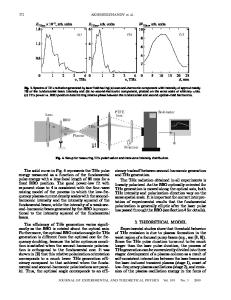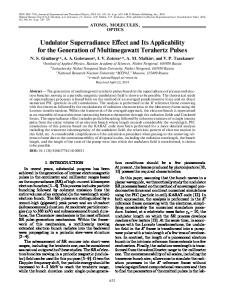Generation of Terahertz Radiation by Multicolor Ionizing Pulses
- PDF / 516,095 Bytes
- 7 Pages / 612 x 792 pts (letter) Page_size
- 61 Downloads / 343 Views
ND LASER PHYSICS
Generation of Terahertz Radiation by Multicolor Ionizing Pulses V. A. Kostina, b, I. D. Laryushina, b, and N. V. Vvedenskiia, b, * a
Institute of Applied Physics, Russian Academy of Sciences, Nizhny Novgorod, 603950 Russia b Lobachevsky State University of Nizhny Novgorod, Nizhny Novgorod, 603950 Russia *e-mail: [email protected] Received April 29, 2020; revised June 7, 2020; accepted June 8, 2020
Analytical formulas have been obtained for the optimal waveform of an ionizing pulse and corresponding maximum density of residual terahertz currents. The found analytical solutions can be implemented with multicolor femtosecond pulses containing the field at the fundamental frequency and several of its lowest harmonics. The amplitudes of odd harmonics in the field optimal for the generation of terahertz radiation are larger than those for neighboring even harmonics. The maximum residual current density increases with an increase in the number of harmonics, in the wavelength of the fundamental harmonic, and in the ionization potential of gas particles and with a decrease in the duration of the ionizing pulse. This maximum residual current density approaches limiting values for saturated ionization when few-cycle pulses are used. DOI: 10.1134/S002136402014012X
medium or parameters of ionizing pulses themselves [1–8, 19–25]. The latter method involves multicolor pulses [21–25] instead of commonly used two-color pulses. At comparatively low intensities of ionizing pulses, when effects of depletion of neutral particles are not too significant, the authors of [21] found that the successive addition of harmonics to the fundamental harmonic significantly increases the current density which is responsible for the generation of THz radiation in the formed plasma. However, an important question of what THz current densities can be achieved using more intense multicolor ionizing pulses corresponding to high degrees of ionization of the formed plasma is still unanswered. In this work, we study how the depletion of neutral particles limits an increase in the THz current density and, correspondingly, the possibility of increasing the brightness of ionization-based THz sources by means of the optimization of the waveform and the intensity of ionizing pulses. For the first time, we find the saturation current density and the corresponding waveform of the ionizing pulse, which allows determining, in particular, the optimal relations between the amplitudes of harmonics forming a multicolor ionizing pulse. As known, the energy of the low-frequency component of THz radiation (with frequencies below the inverse duration of the femtosecond laser pulse) is proportional to the square of the residual current density generated in the plasma [10, 18, 26–28]. As previously shown for two-color fields consisting of linearly polarized monochromatic components, the most intense THz pulses are generated in the case of parallel
Methods for the generation of terahertz (THz) radiation that are based on the ionization of gases by inte
Data Loading...









